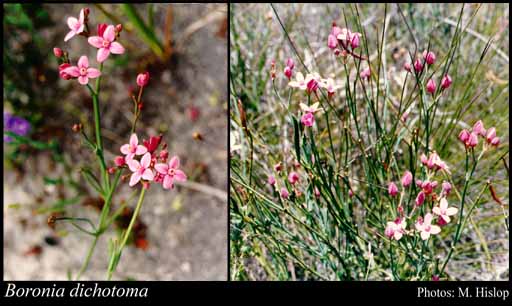- Reference
- Edwards's Bot.Reg. 27: Tab. 47 (1841)
- Conservation Code
- Not threatened
- Naturalised Status
- Native to Western Australia
- Name Status
- Current
Erect, slender perennial, herb or shrub, 0.25-0.7(-1.5) m high. Fl. pink-red/white, Aug to Dec. Sandy soils, clay. Swampy areas, winter-wet flats.

Scientific Description
Shrub, spines absent, +/- cylindrical in cross-section, glabrous. Leaves opposite, simple, 15-30 mm long, 2-7 mm wide, flat or terete, the margins flat, smooth, without distinct raised glands, glabrous; stipular excrescences absent. Flowers in terminal, loose clusters (cymes or panicles); pedicels 6-10 mm long; calyx present, 2.5-4.5 mm long, verrucose (warty), glabrous; corolla red, pink or white or cream, petals four, 7.5-12 mm long, imbricate (overlapping), free, glabrous; stamens twice as many as petals, 2-3 mm long, warty with prominent raised glands, ciliate (with a marginal fringe of hairs); anthers 1.5 mm long, without an appendage. Flowers in August, September, October, November and December. Occurs in the South-West Botanical Province, in the Jarrah Forest, Warren and Swan Coastal Plain IBRA region(s).
Distribution
- IBRA Regions
- Jarrah Forest, Swan Coastal Plain, Warren.
- IBRA Subregions
- Northern Jarrah Forest, Perth, Southern Jarrah Forest, Warren.
- Local Government Areas (LGAs)
- Armadale, Augusta Margaret River, Bunbury, Busselton, Canning, Capel, Cockburn, Collie, Dardanup, Donnybrook-Balingup, Gosnells, Harvey, Kwinana, Murray, Waroona.